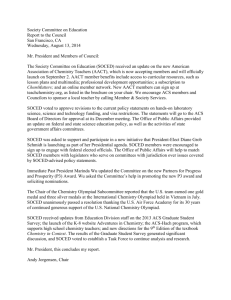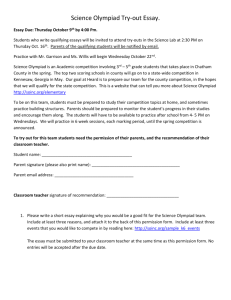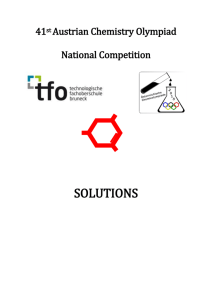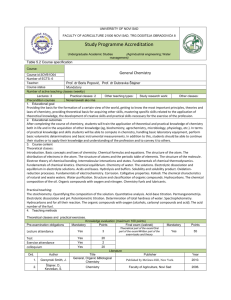Theoretical Competition
advertisement
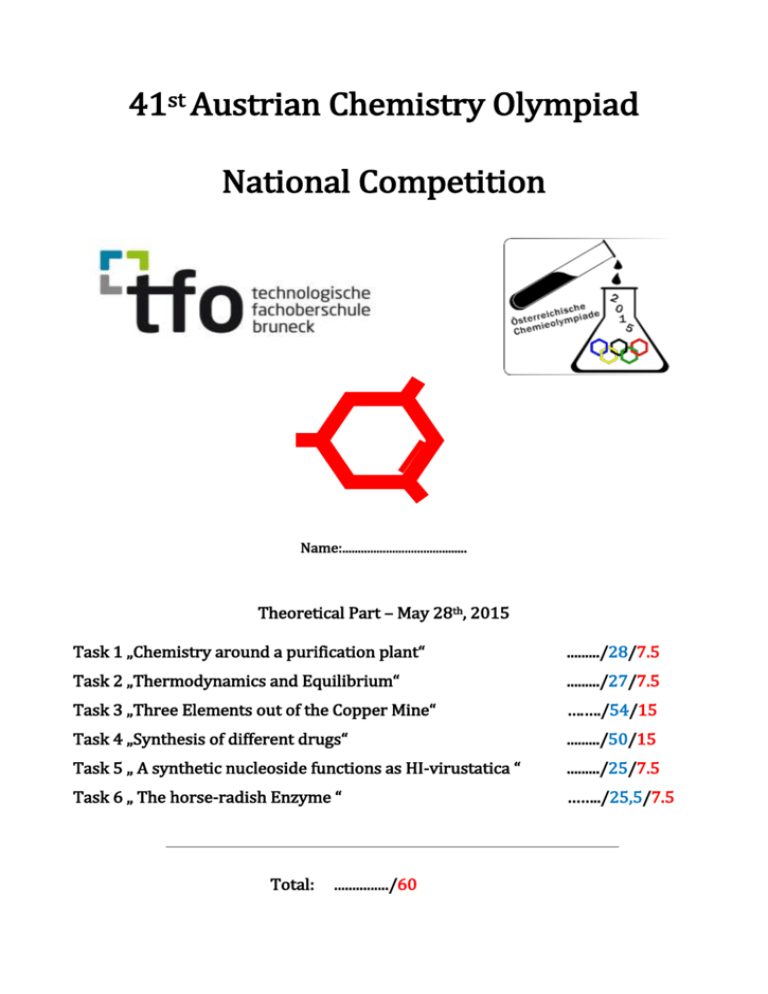
41st Austrian Chemistry Olympiad National Competition Name:........................................ Theoretical Part – May 28th, 2015 Task 1 „Chemistry around a purification plant“ ........./28/7.5 Task 2 „Thermodynamics and Equilibrium“ ........./27/7.5 Task 3 „Three Elements out of the Copper Mine“ ….…./54/15 Task 4 „Synthesis of different drugs“ ........./50/15 Task 5 „ A synthetic nucleoside functions as HI-virustatica “ ........./25/7.5 Task 6 „ The horse-radish Enzyme “ ……../25,5/7.5 Total: .............../60 41st Austrian Chemistry Olympiad National Competition at the TFO Bruneck in South Tyrol Theoretical Part - Tasks Hints You have 5 hours to complete the solutions of the competition tasks. You may only use this paper, draft paper, a periodic table of elements, the page with the formulae, a non programmable calculator, a triangle, a pencil and a blue or black biro, nothing else. Write your answers in the boxes provided for them. Only these answers will be marked. If you don’t have enough space, then you may write on the draft paper with the remark “belongs to part x.xx“, whereby x.xx means the part of the task in italics. Add this draft paper to the booklet. You may take the PTE and the draft paper with you after the competition. This booklet contains 31 pages without the front page. Constants and Data R = 8.314 J/mol.K NA = 6.0221·1023 mol-1 F = 96485 A·s/mol standard conditions: 25°C, 1 bar normal conditions: 0°C, 1.013 bar 1Å = 10-10 m a of solids = 1 normal air pressure: 1.013 bar 273 K = 0°C 1 41st Austrian Chemistry Olympiad National Competition at the TFO Bruneck in South Tyrol Theoretical Part - Tasks Formulae 𝑚 amount of substance 𝑛=𝑀 molar concentration 𝑐=𝑉 mass density 𝜌= equation of ideal gases 𝑝∙𝑉 =𝑛∙𝑅∙𝑇 adiabatic change of ideal gases 𝑝∙𝑉 ideal gases 𝐶𝑃 = 𝐶𝑉 + 𝑅 mono atomic gases 𝐶𝑉 = 2 𝑅 change of state variables (functions) ∆𝑋 = 𝑋𝑓𝑖𝑛𝑎𝑙 − 𝑋𝑖𝑛𝑖𝑡𝑖𝑎𝑙 free standard reaction enthalpy and equilibrium. ∆𝐺 𝑂 = −𝑅 ∙ 𝑇 ∙ 𝑙𝑛𝐾 free reaction enthalpy ∆𝑅 𝐺 = ∆𝑅 𝐺 𝑂 + 𝑅 ∙ 𝑇 ∙ 𝑙𝑛𝑄 free standard reaction enthalpy and redox potential ∆𝐺 𝑂 = −𝑧 ∙ 𝐹 ∙ ∆𝐸 𝑂 efficiency of a heat engine 𝜀= reversible isothermal work 𝑤 = 𝑛 ∙ 𝑅 ∙ 𝑇 ∙ 𝑙𝑛 difference of potentials ∆𝐸 = 𝐸𝐶𝐴𝑇 − 𝐸𝐴𝑁 = 𝐸𝑅𝐸𝐷 − 𝐸𝑂𝑋 Luther’s rule 𝐸°𝑛 = 𝑛 𝑚 𝑉 𝐶 ( 𝑃⁄𝐶 ) 𝑉 = 𝑐𝑜𝑛𝑠𝑡𝑎𝑛𝑡 3 Nernst equation Nernst equation equilibrium constant (Y = concentration variable) 𝑇ℎ𝑜𝑡 −𝑇𝑐𝑜𝑙𝑑 𝑇ℎ𝑜𝑡 𝑉𝑖𝑛𝑖𝑡𝑖𝑎𝑙 𝑉𝑓𝑖𝑛𝑎𝑙 𝑧1 ∙𝐸°1 +𝑧2 ∙𝐸°2…………. 𝑧1 + 𝑧2 ……….. 𝑅∙𝑇 [𝑂𝑥] 𝑂 𝐸 = 𝐸 + 𝑧∙𝐹 𝑙𝑛 [𝑅𝑒𝑑] 𝑅∙𝑇 ∆𝐸 = ∆𝐸 𝑂 − 𝑧∙𝐹 𝑙𝑛𝑄 𝑌 𝑢 ∙𝑌 𝑣 𝐾 = 𝑌𝐶𝑥 ∙𝑌𝐷𝑧 𝐴 𝐵 solubility product for AxBy 𝐾𝑆 = [𝐴 𝑦+ ]𝑥 [𝐵 𝑥− ]𝑦 acid constant 𝐾𝐴 = p-values p𝑋 = −𝑙𝑜𝑔𝑋 Equation for the radioactive decay 𝐴𝑡 = 𝐴0 ∙ 𝑒 −𝜆∙𝑡 half life of the radioactive decay 𝜏= activity of a radio-nuclide 𝐴=𝜆∙𝑁 branching ratio 𝑏𝑖 = Pythagoras’ theorem 𝑐 2 = 𝑎2 + 𝑏 2 2 [𝐻3 𝑂 + ][𝐴− ] [𝐻𝐴] 𝑙𝑛2 𝜆 𝜆𝑖 𝜆 = 𝑛 ∙ 𝑅 ∙ 𝑇 ∙ 𝑙𝑛 𝑝𝑓𝑖𝑛𝑎𝑙 𝑝𝑖𝑛𝑖𝑡𝑖𝑎𝑙 41st Austrian Chemistry Olympiad National Competition at the TFO Bruneck in South Tyrol Theoretical Part - Tasks 3 41st Austrian Chemistry Olympiad National Competition at the TFO Bruneck in South Tyrol Theoretical Part - Tasks Task 1 7.5 points Chemistry around a purification plant The purification plant ARA Pustertal receives waste water from 26 different communities, which then is distributed to four sub-purification plants, one of them being ARA TOBL St. Lorenzen, the biggest one. A special feature of this plant is its part-underground construction. The main goal of a purification plant is the mechanical, biological and chemical treatment of waste water, which then is redirected in a pure state into natural waters. This task deals mainly with part aspects of chemical and biological treatment of waste water. The most important steps to remove nitrogen in terms of NH3 or NH4+ is nitrification and denitrification. In nitrification NH4+ is oxidised in two steps with oxygen from air: 𝐸 𝑂 = +0.940 V 𝐸 𝑂 = +0.866 V NH4+ HNO2 NO3- 1.1. Write balanced reaction equations in ionic form for the single steps as well as for the overall reaction of nitrification. 1.50·104 m3 of waste water with a concentration of 25 mg/L NH4+ run through the nitrification zone of the purification plant daily. The input waste water does not have any buffer capacity. The nitrification is complete while the pH is kept at a constant value. The latter happens by addition of Ca(OH)2. 1.2. Calculate the mass of Ca(OH)2, which is needed hourly to hold the a constant pH in the nitrification zone. 1.3. Calculate the standard potential of the half cell NO3-/ NH4+ 4 41st Austrian Chemistry Olympiad National Competition at the TFO Bruneck in South Tyrol Theoretical Part - Tasks 1.4. What is the potential of the half cell of 1.3., if the pH is brought to 7.0, while all other concentrations remain unchanged? T = 298 K. Show your calculations. Calculation: In the denitrification step nitrate is reduced to nitrogen under anaerobic conditions in the presence of bacteria (nitrosomonas and nitrobacter) using oxidable organic compounds. If there is not enough substrate in the crude water of the nitrification step, the organic compound mentioned may be added artificially (e.g. methanol), whereby CO2 is produced among others. 1.5. Write a balanced reaction equation for the reaction nitrate-methanol in ionic form. Let us look again at the redox chain (standard potentials at pH = 0) of nitrogen between the oxidation numbers +5 and 0. 𝐸 𝑂 = +0.803 V NO3- 𝐸 𝑂 = +1.07 V N2O4 𝐸 𝑂 = +1.59 V 𝐸 𝑂 = +0.996 V HNO2 NO 1.6. Show by calculation, that NO may disproporionate into N2 and NO3-. 5 𝐸 𝑂 = +1.77 V N2O N2 41st Austrian Chemistry Olympiad National Competition at the TFO Bruneck in South Tyrol Theoretical Part - Tasks As a rule, metal ions will be precipitated by addition of sulphide or hydroxide. 1.7. What is the lowest pH, at which iron(III) hydroxide will start to precipitate, if the solution contains 10 g/m3 Fe3+? Show your calculations. pKL(Fe(OH)3) = 38.7 Calculation: Phosphate-ions, eventually coming from detergent additives, must also be removed in order to avoid eutrophication of natural waters. This is done by addition of Fe3+ or Al3+, whereby insoluble tertiary phosphates are generated. Coming from stoichiometry the proportion would be Fe:P = 1:1. In practice the proportion Fe:P = (1,1-1,4):1 is used instead. In case of 22000 m3/d of waste water 250 kg Fe/d are used, the phosphorus content of the water being 5.0 mg P/L. 1.8. Calculate the proportion of amount Fe:P in the above case. Calculation: At pH = 7.0 the solubility of AlPO4 amounts to 96.4 μg/m3. 1.9. Calculate the solubility product of AlPO4 assuming that no protolysis takes place. Calculation: A special heavy contaminated waste water has a pH of 5.0. This pH would cause many difficulties in the purification plant, one of them being a higher phosphate input through the better solubility of AlPO4. 6 41st Austrian Chemistry Olympiad National Competition at the TFO Bruneck in South Tyrol Theoretical Part - Tasks 1.10.Calculate the solubility of AlPO4 at the pH mentioned. hint: you may calculate accurately or you may use sensible simplifications. In the latter case you have to prove mathematically, that the simplifications were valid. If you did not get a value in 1.9., you may use 9.0·10-19 for KS. H3PO4: pKA1 = 2.15; pKA2 = 7.20; pKA3 = 12.4; 7 41st Austrian Chemistry Olympiad National Competition at the TFO Bruneck in South Tyrol Theoretical Part - Tasks Task 2 7.5 points Thermodynamics and Equilibrium A. A thermodynamic cycle As a basic principle in thermodynamics, the work performed by a periodically working machine will be smaller than the heat which is converted to this work. Let us look at a thermodynamic cycle of a machine, which contains 3.0 mol of argon. The cycle consists of the following four steps: A→B: reversible isothermal expansion from pA, VA (30.0 L) to pB (1.70 bar),VB at 800°C B→C: isochoric cooling to 235°C C→D: reversible isothermal compression to VA D→A: isochoric heating 2.1. Calculate the efficiency of the machine. Calculation: 2.3. Calculate the p- and V-values of the points A, B, C, and D, and give a sketch of this thermodynamic cycle using the p-V-diagram at hand (the form of the hyperbolic curves should be estimated). Mark the geometrical part by shading, which corresponds to the net-work of the system. Calculation: sketch: 8 41st Austrian Chemistry Olympiad National Competition at the TFO Bruneck in South Tyrol Theoretical Part - Tasks 2.4. Calculate the work of the reversible isothermal expansion at 800°C and the heat which is released to the surrounding of the machine. Calculation: Let us assume, that, starting from point A, the machine expands in a reversible adiabatic mode to VB. 2.5. Calculate the final temperature and the final pressure of this adiabatic expansion. Calculation: 9 41st Austrian Chemistry Olympiad National Competition at the TFO Bruneck in South Tyrol Theoretical Part - Tasks B. Boudouard‘s Equilibrium Boudouard‘s equilibrium applies to the reaction: C(s) + CO2(g) ⇄ 2 CO(g) The diagram to the right shows the temperature dependence of the composition of the equilibrium mixture at pg = 1.0 bar. 2.6.What is the molar percentage of CO in the equilibrium mixture at 727°C and 1 bar? 2.7. Calculate KP of the reaction at 727°C and a total pressure of 0.80 bar. Calculation: 2.8. Calculate the percentage of CO at 727°C and a total pressure of 2.0 bar. Calculation: 10 41st Austrian Chemistry Olympiad National Competition at the TFO Bruneck in South Tyrol Theoretical Part - Tasks C. An Isomerisation Glucose-6-phosphat isomerises to give fructose-6-phosphat in the first step of the glycolysis. The free standard reaction enthalpy of this reaction amounts to ∆𝑅 𝐺 𝑂 = 1.7 𝑘𝐽 bei 298 K. 2.9. Calculate the equilibrium constant of the reaction and the composition of the equilibrium mixture at 25°C. Calculation: 2.10. Calculate the free reaction enthalpy of this reaction ∆𝑅 𝐺 depending on the fraction of fructose-6-phosphat in optional reaction mixtures (at least 6 values), and draw a sketch of this dependency in the given diagram. ∆𝑅 𝐺 (𝑘𝐽) +10.0 +5.0 0.0 -5.0 0.0 11 0.5 1.0 𝑥(𝐹6𝑃) 41st Austrian Chemistry Olympiad National Competition at the TFO Bruneck in South Tyrol Theoretical Part - Tasks Task 3 15 points Three Elements out of the Copper Mine A. Copper itself The density of pure Cu is ρ = 8.29 g/cm3 . Its lattice is cubic closed packaged. 3.1. Calculate the lattice constant in Angström (1Å = 100 pm) lattice constant a = Your calculation: Copper from the mine in Prettau (South Tyrol) was once valued for its purity and its ductility. In other places people were seeking for more hardness and therefore made alloys like brass, an alloy from copper and zinc. A certain sample of brass (ρ = 8.51 g/cm3; mole fractions: x(Cu) = 0.750, x(Zn) = 0.250) was investigated by x-ray crystallography. It showed cubic closed packaging with the Zn-atoms stochastically replacing Cu-atoms. One can thus assume a „statistical atom“ CuxZn1-x sitting on all points of the face centred cubic lattice. 3.2. Calculate the radius of this statistical atom. calculated radius r = Your calculation: Gold also forms several alloys with copper. To the right you see the elementary cells of two compounds. 12 41st Austrian Chemistry Olympiad National Competition at the TFO Bruneck in South Tyrol Theoretical Part - Tasks 3.3. Write down the empirical formulae of these two compounds. A: B: B. Copper minerals and the production of copper Among the most important copper ores are chalcocite Cu2S, chalcopyrite CuFeS2 and bornite or peacock ore Cu5FeS4. During the pyrometallurgical production of copper from Cu5FeS4 generally the following steps can be found: a. b. c. d. Roasting: Cu5FeS4 is heated while being exposed to oxygen. Cu2S, Fe3O4 and SO2 are formed. Smelting: Fe3O4 reacts with CO and the high-melting, binary compound X. Compound Y and CO2 are formed. X contains 53.25% O, Y contains 31.41 % O and 54.81% Fe. In the liquid phase compound Y is immiscible with copper(I)-sulfide and can therefore readily be separated as slag. Removing sulphur: The Cu2S obtained in a. is partly converted to Cu2O by roasting. Cu2S and Cu2O are now available in the necessary stoichiometric proportion and react with one another forming copper and SO2. 3.4. Determine the formulae of the compounds X and Y. X: Y: Your calculation: 3.5. Give balanced equations for the reactions in steps a. to d.: a. b. c. d. Unfortunately the composition of the actually found substances is not always equal to that of the formulae and can also vary within certain margins. One can visualize ternary systems using so called ternary plots. In the Cu-Fe-S-system the pure elements are positioned at the vertices of an equilateral triangle. Along one edge of the triangle the mass fraction of a single element is shown. 13 41st Austrian Chemistry Olympiad National Competition at the TFO Bruneck in South Tyrol Theoretical Part - Tasks Illustration of the ternary plot 0 S 100 All substances on this line contain 22% Cu Notice that the line lies opposite of Cu-corner 80 20 % 60 ) 40 % Cu Cu ,6% 34 (w /w w) w/ S( CuFeS2 (34,6% Cu, 30,4% Fe, 35,0% S) 60 Cu2S 40 35,0% S ,4 % Fe (79,9% Cu und 20,1 % S) 20 30 80 100 0 Cu 0 20 40 60 80 100 % Fe (w/w) 3.6. In the empty plot denote the compositions of pyrite (FeS2) (46.5 % Fe) and cubanite (CuFe2S3)(23.4% Cu, 41.1% Fe). 0 S 100 80 20 % Cu w) w/ (w /w S( ) % 60 40 60 40 80 20 100 0 Cu 0 20 40 60 80 100 % Fe (w/w) gray region: Cu-Fe-S- compositions useable for pyrometallurgy 3.7. For the Cu-Fe-S-compositions useable in pyrometallurgy denote: a) the maximum percentage of Fe such a mixture may have ____________________% b) the minimum percentage of S such a mixture must have ____________________% 14 Fe Fe 41st Austrian Chemistry Olympiad National Competition at the TFO Bruneck in South Tyrol Theoretical Part - Tasks C. Strange copper compounds Compounds of Cu(I) and Cu(II) are comparatively common. Less known is Cu(III). Due to its high standard potential (E°(Cu3+/Cu2+) = +2.4V) it is not stable in aqueous solutions as an ion but it can be stabilized by complex ligands. If one treats a mixture of KCl and CuCl2 with fluorine, one gets potassium hexafluoridocuprate(III). In this compound the anion shows octahedral coordination. 3.8. Give a balanced equation for the formation of potassium hexafluoridocuprate(III). 3.9. Write down the entire electron configuration for Cu(III) in its ground state. 3.10. Depict the splitting of the d-orbitals for the complex and tick the right box: Scheme of the d-Orbitals: diamagnetic paramagnetic Another ligand stabilizing Cu(III) in a complex is periodic acid, especially as H5IO6 (ortho-periodic acid). Its fourfold negatively charged anion occurs in a complex with Cu(III) that contains 12.4% Cu. The Cu(III) central atom in this complex shows square planar coordination. 3.11. Draw a Lewis – formula and tick the right box: structure of H5IO6: 3.12. geometry according to VSEPR linear trigonal planar tetrahedral square pyramidal octahedral Write down the molecular formula of the copper-containing complex anion: Formula: Justify by calculation 15 41st Austrian Chemistry Olympiad National Competition at the TFO Bruneck in South Tyrol Theoretical Part - Tasks 3.13. Propose a structure for this anion: D. Arsenic Arsenic frequently occurs in copper mines. In Ötzi’s hair (Ötzi, the mummy found in the Ötztal Alps), comparatively high levels of arsenic have been found. It has thus been speculated that he had been involved with copper mining. In this task a radiochemical aspect shall be considered. The isotope 74As shows a mean half-life of 17.77 days. It undergoes β+-decay (66,00%) as well as β–-decay (34,00%). 3.14. Write down complete, balanced equations for both decays. Denote the nuclides with the appropriate mass numbers. β+: β–: 3.15. Calculate the decay constant for the β+ decay in s -1. β+: Your calculation: 74As does not naturally occur. It can be produced in nuclear reactions. For instance by irradiation of germanium with deuterium nuclei: Ge + 21d→74 As+γ. Ge has 5 stable isotopes: 70Ge (20.5%), 72Ge(27.4%), 73Ge(7.8%), 74Ge(36.5%), and 76Ge(7.8%). In a sample of 0.743g GeO2 3.4 ppb (1ppb = 10−9) of the appropriate nuclide were converted according to the reaction given. 3.16. Indicate the mass number of the Ge-isotope that gets converted according to the equation given above. A= 16 41st Austrian Chemistry Olympiad National Competition at the TFO Bruneck in South Tyrol Theoretical Part - Tasks 3.17. Calculate the total activity of the sample (β+ and β-) immediately after the irradiation. activity A = Your calculation: E. Reactions of square planar platinum(II) complexes During electro refining of copper several noble metals find their way to the anode slime. One of them is platinum which is popular for its square planar complexes. In the reaction scheme given below you shall assign the letters A, B, C and D to the ligands py (pyridine), NH3, Cl- and NO2- respectively. The roman numerals denote the complexes. For clarity’s sake the leaving ligands have not been put into the scheme. The reactions are governed by the trans-effect which decreases along this sequence: CN– > SO32– > NO2– > Br– > Cl– > py > NH3 > H2O B A B A IV A C 2- [PtA2CD] Pt C II D Pt B A A I Zn/HCl C A B Pt A A D [PtA2BC]- V VI III 3.18. A: 3.19. IV 3.20. Indicate which letter stands for which ligand. B: C: D: Draw configuration formulae for the complexes IV - VI. V VI How many isomers are possible for complex VI? There are ______________ possible isomers. 17 [PtABCD] 41st Austrian Chemistry Olympiad National Competition at the TFO Bruneck in South Tyrol Theoretical Part - Tasks Task 4 15 points Synthesis of different drugs A. Verapamile Verapamile is a drug out of the group of calcium channel blockers which are used in treatment of blood high pressure and cardiac dysrhythmia. The structure of Verapamile is shown below, it has one stereogenic centre. 4.1. Write down the absolute configuration of this stereogenic centre. Verapamile can be put together from two fragments C and M. The synthesis of C and M are shown below. In both cases the starting material is compound A, 3,4-dimethoxy-acetonitrile. The reaction scheme for the synthesis of C is: NaCNBH3 + HCHO a B C (C11H17NO2) A 4.2. Draw constitution formulae of B, C and a possible formula of the reagent a. Reagent a: B C For the production of the second fragment (M), A is transformed in two steps into the methyl ester E: H+/H2O b A D oder OH-/H 2O E 18 41st Austrian Chemistry Olympiad National Competition at the TFO Bruneck in South Tyrol Theoretical Part - Tasks 4.3. Draw a constitution formula of compound D. Draw a formula of reagent b and suggest two conditions of the reaction from D to E. D b: 2 conditions: E is transformed in three steps into the racemic acid G. G will undergo racemic resolution; only the enantiopure compound H will be used furthermore. 1. c 1. e 2. d 2. f 1. g F E 2. h G 4.4. Write possible formulae of reagents c, d, e, f , g, and h. c: f: d: g: e: h: Hint for the scheme below: J and K both contain the element boron. SOCl2 R2BH I NH3 K J H2O2 H M C16H22ClNO2 19 PCl5 L 41st Austrian Chemistry Olympiad National Competition at the TFO Bruneck in South Tyrol Theoretical Part - Tasks 4.5. Draw constitution formulae of the compounds I, J, K, L, and M. I J K L M In the presence of Et3N M and C combine to the desired product Verapamile. 4.6. Which type of reaction is meant in the step of M and C to Verapamile? What is the reason for adding Et3N? 20 41st Austrian Chemistry Olympiad National Competition at the TFO Bruneck in South Tyrol Theoretical Part - Tasks B. Platynecine Pyrrolizidine-alkaloids and their unnatural analogues occupy an important place in organic chemistry and show a broad variety of physiological activities. Polyhydroxylated pyrrolizidines imitate the structures of sugars and inhibit various glycosidases, a property which can be useful in the treatment of diabetes, influenza and HIV. We show a possible synthesis of the dihydroxylated pyrrolizidine alkaloide Platynecine, 1-hydroxy-7hydroxymethyl-pyrrolizidine: 4.7. Assign absolute configurations to the stereogenic centres in the formula above. The synthesis of racemic Platynecine affords the construction of two annulated five membered rings with a nitrogen-atom in common. The reaction scheme below shows the formation of the first five membered ring. It starts from the methylester of 4-iodo-butanoic acid (=ethyl-4-iodobutanoate) and dibenzylamin (abbreviation for benzyl is „Bn“). (Hint: Q is a cyclic enamine). ethyl-4-iodobutanoate N NH(Bn)2 O NaOEt H2/Pd/C 1 Äqu. H2/Kat. Q P C10H17NO5 4.8. Name the reaction type of N with diethyl oxalate. 4.9. Draw a potential mechanistic pathway for the first step of the reaction with diethyl oxalate. 21 41st Austrian Chemistry Olympiad National Competition at the TFO Bruneck in South Tyrol Theoretical Part - Tasks 4.10. Draw constitution formulae of compounds N, O, P, and Q. N O P Q The second five membered ring is built according to the following scheme leading to the desired product platynecine. NaH R C15H25NO6 H3O+ NaBH4, NaOH i [S] T dann H3O+ C8H11NO3 Hint: R is a monocyclic compound, T is a tricyclic compound, [S] is not isolated. 22 41st Austrian Chemistry Olympiad National Competition at the TFO Bruneck in South Tyrol Theoretical Part - Tasks 4.11. Draw steric formulae of the compounds R, S, and T and suggest a possible reagent for i. R S T reagent i: 4.12. Draw the species which is formed in the reaction of R with the base NaH. By using a curly arrow show the attack which finally leads to the formation of the bicyclus. C. Norfloxacine Norfloxacine is a synthetic antibiotic which shows a high in vitro-activity against gram-negative and gram-positive aerobic bacteria. Norfloxacine belongs to the group of the fluorquinolons. The parent compound of the quinolone-antibiotics which all have a carboxyl acid group in the 3-position is shown below. Retro consideration suggests the formation from aniline and a derivative of malonic ester. 23 41st Austrian Chemistry Olympiad National Competition at the TFO Bruneck in South Tyrol Theoretical Part - Tasks This derivate of malonic ester is rather unstable; the enolether of this compound (U) is used instead in the synthesis. The synthesis of Norfloxacine can be performed in a few steps according to the scheme below: W U C12H9ClFNO3 V 1. K2CO3 2. C2H5I 1. OH-/H2O + Z Norfloxacin Y X 2. H3O+ 4.13. Draw constitutional formulae of the compounds W, X, Y, and Z. W X Y Z: 4.14. Name the reaction type of the transformation of V to W. U is easily made from diethylmalonate and ethyl orthoformate. 4.15. Write a balanced equation for this reaction. 24 41st Austrian Chemistry Olympiad National Competition at the TFO Bruneck in South Tyrol Theoretical Part - Tasks Task 5 7.5 points A synthetic nucleoside functions as HI-virustatica This problem deals with the HI-Virus, which belongs to the group of retroviruses. A retrovirus exhibits RNA as genetic information. All viruses are specialised to reproduce in a host cell. Hence, there is a need to transcribe the RNA of the virus into DNA. The virus provides the enzyme for the transcription process. This problem deals with an antiviral agent, which prevents the reproduction of the virus in the host cell. Use the following structural formulae to complete the tasks. 5.1. Name the three building blocks of a nucleotide. 5.2. Design the structure of a 3-Deoxy-“purine nucleotide“. 5.3. Show the equation leading from the chain form of (2S, 3R, 4 R)-2,3,4,5-Tetrahydroxypentanal to α-D-Arabinofuranose. Depict the reactant in Fischer projection and the product in Haworth projection. 5.4. Name the reaction type leading from the open chain to the ring form. 25 41st Austrian Chemistry Olympiad National Competition at the TFO Bruneck in South Tyrol Theoretical Part - Tasks Elemental analysis of nucleoside A resulted in the following composition (w/w): 44.I % C 4.9 % H 26.I % O 17.I % N 7.7 % F This nucleoside contains a fluorine-modified base. Note that there is a C-F bond in instead of a C-H bond. The fluorine-atom is located at a maximum distance from the N-glycosidic bond. The modified nucleoside is able to form a phosphoric acid diester, as usual. 5.5. Calculate the sum-formula of A. 5.6. Design the structure formula of A. Starting with nucleoside A the following reaction scheme shows the synthesis of the virustatic agent G. 26 41st Austrian Chemistry Olympiad National Competition at the TFO Bruneck in South Tyrol Theoretical Part - Tasks It is the minimum structural modification of A, only that causes the antiviral activity of G. Given that the essential step has to proceed selectively at a functional group, there is a need to protect other functional groups. Hints: Ph = phenyl Incorporate the steric hindrance by the reagent (Ph)3CCl in the reaction B to C. The step leading from E to F does not follow the rule of Saytzeff. A mass spectrum of product G leads to the molecular ion m/z (M+.) 5.7. Write down the structural formulae of the substances B to G into the boxes. Abbreviate Phenyl with Ph as usual. If the base is not involved in a reaction, use the abbreviation ”base“. Use a Guanine-nucleoside with a common sugar with a primary hydroxyl group if you are not able to derive the formula for A. B: C: D: E: 27 41st Austrian Chemistry Olympiad National Competition at the TFO Bruneck in South Tyrol Theoretical Part - Tasks F: G: G-like agents exhibit special structural features. They cause the way of molecular action as an antiviral agent. 5.8. Write down the letters t (true statement) and w (wrong statement) in the boxes. Randomly placed crosses lead to a deduction according to the scores. The absence of the 2´ hydroxyl group causes the way of molecular action. The nucleoside analogue G vies competitively with dCTP. The nucleoside analogue G vies competitively with CTP. The nucleoside analogue G vies competitively with TTP. Chain termination at the DNA elongation is the key factor of the inhibitory effect. The reverse transcriptase is a DNA-dependent DNA polymerase. This enzyme uses the wrong nucleotide for transcription. The reverse transcriptase is an RNA-dependent DNA polymerase. This enzyme uses the wrong nucleotide for transcription. 28 41st Austrian Chemistry Olympiad National Competition at the TFO Bruneck in South Tyrol Theoretical Part - Tasks Task 7 7.5 Points The horse-radish Enzyme Catalase is a peroxidase originally found in horse-radish. It catalyzes the decomposition of hydrogen peroxide and hence its detoxification. Additionally, this enzyme catalyzes the oxidation reaction of iodide ions, which are important for the biosynthesis of the thyroid hormone thyroxine. Inorganic catalysts could also cause the decomposition of hydrogen peroxide. The following partial reactions suggest a mechanism for the catalysis with iodide ions: H3O+ + H2O2 ⇆ H3O2+ + H2O k1 (forward reaction), k-1 (reverse reaction) H3O2+ + I- ⇾ HOI + H2O k2 HOI + H2O2 ⇾ H3O+ + I- (fast) k2>>k1 and k-1 respectively 6.1. Using the partial equations, derive a law for the rate of the reaction. Enzyme kinetics Hydrogen peroxide is also decomposed by enzymatic catalysis. Leonor Michaelis and Maud Menten were significantly involved in the development of a kinetic model. They established the following law for the reaction rate: 𝑒𝑞. 𝐼: 𝑣 = 𝑣𝑚𝑎𝑥 ∙ [𝑆] 𝐾𝑀 + [𝑆] The enzymatically transformation of a substrate at 25°C has a Michaelis constant of KM = 0.046. The value of the rate of the reaction is 1.04 ∙ 10−3 mol ∙ L−1 ∙ s −1 at a substrate concentration of 0.105 mol·L-1 6.2. Write down the unit of KM.. 6.3. Calculate the maximum rate of this reaction. 29 41st Austrian Chemistry Olympiad National Competition at the TFO Bruneck in South Tyrol Theoretical Part - Tasks 6.4. Draw a graph of eq. 1 by plotting v against [S]. It is not necessary to scale the axes. 6.6. Show by calculation which condition leads to v = vmax. 6.7. A linear transformation of eq. I leads to the equation of Lineweaver and Burk. Perform a linear transformation of eq. I and show your calculation by forming the reciprocal of the Michaelis-Menten-equation. Sketch a graph. It is not necessary to scale the axes. Name the axes and highlight the ordinate axis, when x = 0. Find an expression for the slope of the function. For enzymatically ruled reactions the following mechanism is assumed: 30 41st Austrian Chemistry Olympiad National Competition at the TFO Bruneck in South Tyrol Theoretical Part - Tasks First, the enzyme reacts with the substrate which is present in abundance. The so formed enzymesubstrate complex is transformed into the product in a slow step. Use the steady-state conditions. Note that the concentration of the enzyme is given by [𝐸𝑡𝑜𝑡𝑎𝑙 ] = [𝐸] + [𝐸𝑆] The substrate is present in abundance. Hence, [𝑆0 ] ≈ [𝑆] can be assumed. In an intermediate step several constants arise. Transform the equation in a way that all constants are in the denominator, so that they can be replaced by a special constant. 6.8. Derive the rate law (Michaelis-Menten eq.) and show your calculation step by step (application of the steady state model). 31
